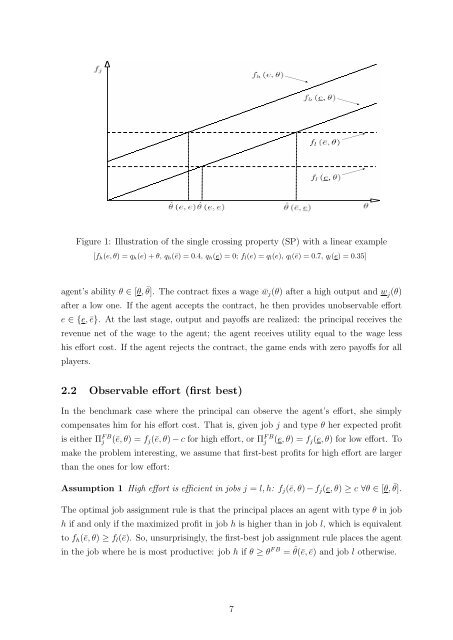Job Assignments under Moral Hazard - School of Economics and ...
Job Assignments under Moral Hazard - School of Economics and ...
Job Assignments under Moral Hazard - School of Economics and ...
You also want an ePaper? Increase the reach of your titles
YUMPU automatically turns print PDFs into web optimized ePapers that Google loves.
Figure 1: Illustration <strong>of</strong> the single crossing property (SP) with a linear example<br />
[fh(e, θ) = qh(e) + θ, qh(ē) = 0.4, qh(e) = 0; fl(e) = ql(e), ql(ē) = 0.7, ql(e) = 0.35]<br />
agent’s ability θ ∈ [θ, ¯ θ]. The contract fixes a wage ¯wj(θ) after a high output <strong>and</strong> w j(θ)<br />
after a low one. If the agent accepts the contract, he then provides unobservable effort<br />
e ∈ {e, ē}. At the last stage, output <strong>and</strong> pay<strong>of</strong>fs are realized: the principal receives the<br />
revenue net <strong>of</strong> the wage to the agent; the agent receives utility equal to the wage less<br />
his effort cost. If the agent rejects the contract, the game ends with zero pay<strong>of</strong>fs for all<br />
players.<br />
2.2 Observable effort (first best)<br />
In the benchmark case where the principal can observe the agent’s effort, she simply<br />
compensates him for his effort cost. That is, given job j <strong>and</strong> type θ her expected pr<strong>of</strong>it<br />
F B<br />
F B<br />
is either Πj (ē, θ) = fj(ē, θ) − c for high effort, or Πj (e, θ) = fj(e, θ) for low effort. To<br />
make the problem interesting, we assume that first-best pr<strong>of</strong>its for high effort are larger<br />
than the ones for low effort:<br />
Assumption 1 High effort is efficient in jobs j = l, h: fj(ē, θ) − fj(e, θ) ≥ c ∀θ ∈ [θ, ¯ θ].<br />
The optimal job assignment rule is that the principal places an agent with type θ in job<br />
h if <strong>and</strong> only if the maximized pr<strong>of</strong>it in job h is higher than in job l, which is equivalent<br />
to fh(ē, θ) ≥ fl(ē). So, unsurprisingly, the first-best job assignment rule places the agent<br />
in the job where he is most productive: job h if θ ≥ θ F B = ˆ θ(ē, ē) <strong>and</strong> job l otherwise.<br />
7
















